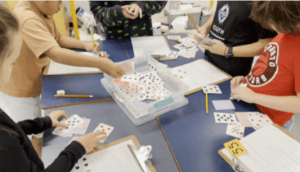 I have long been exploring the ways that games can be used to help students work on needed goals, long after the “material has been covered.” For example, if you get to the end of your multiplication unit and you have a bunch of students that are still not fluent and confident with multiplication skills and strategies, playing games can help. So long as you have a routine for supporting game play, intentionally use games for growth, and have a good set of games to choose from, students will play them and get not only better at their skills, but also at their creative and strategic use of those skills. It works.
I have long been exploring the ways that games can be used to help students work on needed goals, long after the “material has been covered.” For example, if you get to the end of your multiplication unit and you have a bunch of students that are still not fluent and confident with multiplication skills and strategies, playing games can help. So long as you have a routine for supporting game play, intentionally use games for growth, and have a good set of games to choose from, students will play them and get not only better at their skills, but also at their creative and strategic use of those skills. It works.
Now, you could assess students using measures other than the games themselves–small check in quizzes or activities–but why not use the games themselves? Plus, if you have reluctant and/or highly anxious math learners, games can be a friendly way to get important information for targeted planning or a sense of how things are progressing. Unlike tests or other paper-based activities, assessing through games seems to benefit from engaging directly with students through conversation and being a game participant. This form of assessment also works incredibly well with self-assessment, so long as students know what they are aiming for and can name/identify strategies.
At this point in my exploration, I have tested 3 games as potential assessment tools:
- Mathtzee (an souped-up version of Yahtzee)
- The Product Game by Games for Young Minds
- 15 Scratch Assessment (our game board, but the idea borrowed from a teacher who played it regularly in their class)
- Capture the Square Subitizing to Multiplying (also our version, and also borrowed from a teacher I knew who borrowed it from someone else. Ah teachers!)
We tested Mathzee with vulnerable grade 10 students from one our district’s alternate secondary schools as well as with one Math Foundations 10 students at a local high school. We are set to try it with grades 6 to 8 as well.
We tested Slideline and Fill the Stairs with multiple classes of grade 6-8 students at local middle schools.
Capture the Square is commonly played at the Elementary level. Levels of the game are chosen either by teachers or students.
